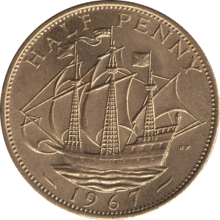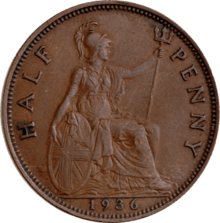Halfpenny (British pre-decimal coin)
The British pre-decimal halfpenny (1/2d) coin, usually simply known as a ha'penny (pronounced /ˈheɪpəni/), historically occasionally also as the obol[1] and once abbreviated ‘ob’ (from the Latin ‘obulus’),[2] was a unit of currency that equalled half of a penny or 1/480 of a pound sterling. Originally the halfpenny was minted in copper, but after 1860 it was minted in bronze. In the run-up to decimalisation it ceased to be legal tender from 31 July 1969.[3] The halfpenny featured two different designs on its reverse during its years in circulation. From 1672 until 1936 the image of Britannia appeared on the reverse, and from 1937 onwards the image of the Golden Hind appeared.[4] Like all British coinage, it bore the portrait of the monarch on the obverse.[5]
United Kingdom | |
| Value | 1/480 pound sterling |
|---|---|
| Mass | (1860–1967) 5.67 g |
| Diameter | (1860–1967) 25.48 mm |
| Edge | Plain |
| Composition | (1672–1860) Copper (1860–1967) Bronze |
| Years of minting | 1672–1967 |
| Obverse | |
 | |
| Design | Profile of the monarch (Elizabeth II design shown) |
| Designer | Mary Gillick |
| Design date | 1953 |
| Reverse | |
 | |
| Design | Golden Hind (Britannia on earlier mintages) |
| Designer | Thomas Humphrey Paget |
| Design date | 1937 |
"Halfpenny" was colloquially written ha’penny, and "1+1/2d" was spoken as "a penny ha’penny" /ə ˈpɛni ˈheɪpni/ or three ha’pence /θriː ˈheɪpəns/.[6] Before Decimal Day in 1971 there were 240 pence in one pound sterling. Twelve pence made a shilling, and twenty shillings made a pound. Values less than a pound were usually written in terms of shillings and pence, e.g. 42 pence would be three shillings and sixpence (3/6), pronounced "three and six", whereas 3 shillings even would be "3s" or, on a sign in a shop, "3/-" (the dash usually being written instead of 0 for pence). Values of less than a shilling were simply written in pence, e.g. eightpence would be 8d (the "d" standing for the Latin word denarii (sing. denarius, a common coin in Roman Britain).
Design

The original reverse of the bronze version of the coin, designed by Leonard Charles Wyon, is a seated Britannia, holding a trident, with the words HALF PENNY to either side. Issues before 1895 also feature a lighthouse to Britannia's left and a ship to her right. Various minor adjustments to the level of the sea depicted around Britannia, and the angle of her trident were also made over the years. Some issues feature toothed edges, while others feature beading.
Over the years, various different obverses were used. Edward VII, George V, George VI and Elizabeth II each had a single obverse for halfpennies produced during their respective reigns. Over the long reign of Queen Victoria two different obverses were used, but the short reign of Edward VIII meant no halfpennies bearing his likeness were ever issued.
During Victoria’s reign, the halfpenny was first issued with the so-called ‘bun head’, or ‘draped bust’ of Queen Victoria on the obverse. The inscription around the bust read VICTORIA D G BRITT REG F D. This was replaced in 1895 by the ‘old head’, or ‘veiled bust’. The inscription on these coins read VICTORIA DEI GRA BRITT REGINA FID DEF IND IMP.
Coins issued during the reign of Edward VII feature his likeness and bear the inscription EDWARDVS VII DEI GRA BRITT OMN REX FID DEF IND IMP. Similarly, those issued during the reign of George V feature his likeness and bear the inscription GEORGIVS V DEI GRA BRITT OMN REX FID DEF IND IMP.
A halfpenny of King Edward VIII (1936) does exist, dated 1937, but technically it is a pattern coin i.e. one produced for official approval; it would probably have been due to receive this approval at about the time that the King abdicated. The obverse shows a left-facing portrait of the king (who considered this to be his best side, and consequently broke the tradition of alternating the direction in which the monarch faces on coins — some viewed this as indicating bad luck for the reign); the inscription on the obverse is EDWARDVS VIII D G BR OMN REX F D IND IMP.
The pattern coin of Edward VIII and regular issue halfpennies of George VI and Elizabeth II feature a redesigned reverse displaying Sir Francis Drake's ship the Golden Hind.
George VI issue coins feature the inscription GEORGIVS VI D G BR OMN REX F D IND IMP before 1949, and GEORGIVS VI D G BR OMN REX FIDEI DEF thereafter. Unlike the penny, halfpennies were minted throughout the early reign of Elizabeth II, bearing the inscription ELIZABETH II DEI GRA BRITT OMN REGINA F D in 1953, and ELIZABETH II DEI GRATIA REGINA F D thereafter.
Mintages
| Victoria (Veiled bust) |
|---|
|
| Edward VII |
|---|
|
| George V |
|---|
|
| George VI |
|---|
|
| Elizabeth II |
|---|
|
See also
Ha’porth: British English i.e. ‘halfpenny-worth’ or ‘halfpennyworth’ pronounced /ˈhɛɪpəθ/ in Conservative RP, or /ˈheɪpəθ/ in Modern or Contemporary RP.[7][8]
In literal use usually written out in full[9][10][11] although still never pronounced phonetically:[12][13][14] e.g. ‘A halfpennyworth of chips’.[15] In figurative use usually said disparagingly: e.g. ‘I've been dying for somebody with a ha’porth of wit and intelligence to talk to’.[16] ‘…and saying it doesn't make a halfpennyworth of difference!’[17][18] (from Alan Bennet's A lady Of Letters, written and produced in 1987, some sixteen years after decimalisation and three years after the New Halfpenny—(i.e. the decimal 1/2p)—had been demonetised and withdrawn from circulation, thus further illustrating the continued traditional or idiomatic two-syllable pronunciation). Also used in the once common phrase: ‘daft ha’porth’.[9][10][11][19]
References
- Albert Peel, Seconde parte of a register: being a calendar of manuscripts under that title (Cambridge, England: Cambridge University Press, 2010), p. 175, note.
- "University of Nottingham Manuscripts and Special Collections 'Research Guidance' Weights and Measures § Money". Retrieved 12 March 2014.
- "Halfpenny (Pre-decimal), Coin Type from United Kingdom". Retrieved 21 April 2017.
- "Halfpenny and Farthing". Royal Mint Museum. Retrieved 10 May 2014.
- Michael, Thomas and Cuhaj, George S. Collecting World Coins: Circulating Issues 1901 - Present. Krause Publications, 2001.
- "Halfpenny". Oxford English Dictionary (3rd ed.). Oxford University Press. September 2005. (Subscription or UK public library membership required.)
- "Halfpennyworth (with IPA and audio files)". Lexico: Powered by Oxford. Archived from the original on 2 October 2019. (via Internet Archive WayBack Machine: 02 Oct 2019)
- "Fowler's Dictionary of Modern English Usage: Page 363, No. 6 ". Oxford University Press. Retrieved 26 March 2015.
- "Prof. John Wells's Phonetic Blog".‘Did I hear you “aright”?’
- "Professor John Wells, University College London".PhD General Linguistics, UCL Psychology & Language Sciences
- "University College London Dept. of Psychology and Language Sciences, Faculty of Brain Sciences". Archived from the original on 9 November 2012.Professor Emeritus John Christopher Wells' C.V. (via Internet Achieve)
- "Why does the word Halfpennyworth only have One Syllable?: It doesn't. Historically it was pronounced with Two". Gareth Roberts, Linguistics Professor, PhD, U. of Edinburgh (2010). Retrieved 15 May 2017.
- "University of Pennsylvania, Department of Linguistics: Assistant Professor Gareth Roberts". Retrieved 11 June 2019.
- "Dr Gareth Roberts, PhD Linguistics, The University of Edinburgh, 2010". Retrieved 17 July 2014.
- "Blackadder Goes Forth "Corporal Punishment" (Series 4 No. 2)".
- "Bless Me Father "Baptism of Fire" (Series 1 Episode 1)".
- "Talking Heads "A lady Of Letters" With Patricia Routledge (Part 3)"..
- "Talking Heads by Alan Bennett No. 3 "A lady Of Letters" (Runtime 33.19)". circa 24 min. 12. sec.
- "BBC Breakfast featurette on "Ethel and Ernest" (Originally aired 2016)".
External links
| Wikimedia Commons has media related to Halfpenny. |